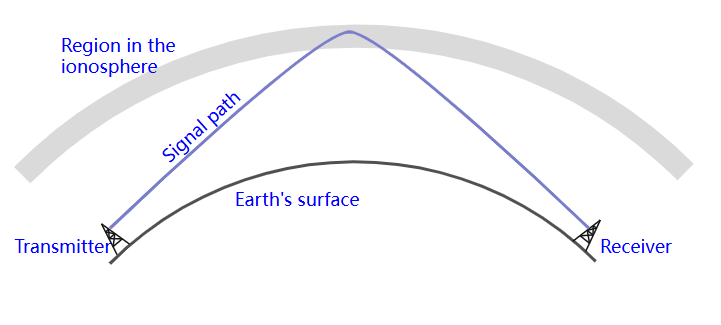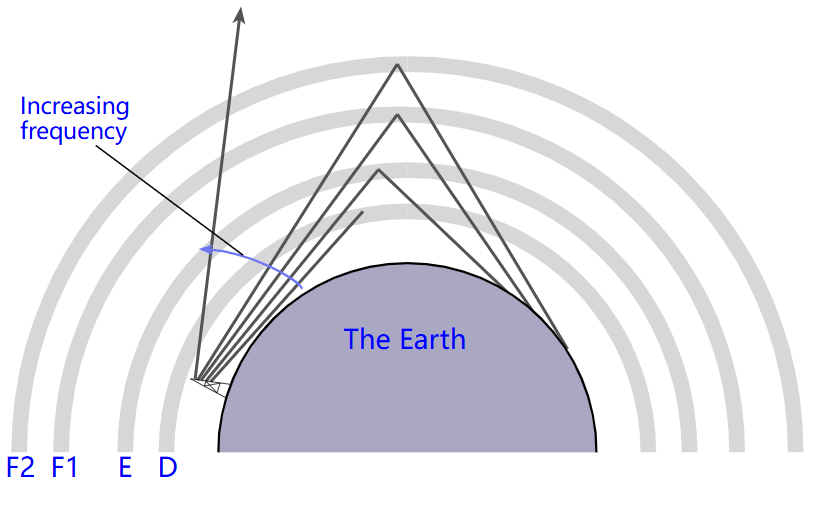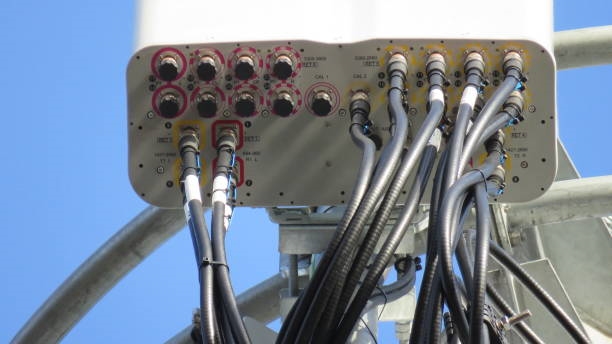Overview
Ionospheric propagation is the primary radio propagation mode used in the medium- and high-frequency portions of the radio spectrum.
The basic concepts behind using the ionosphere for HF propagation are straightforward. Studying them is both interesting and useful for anyone involved in HF radio communications.
HF ionospheric propagation allows reception and communication with stations around the world. Understanding propagation modes and how they change over time helps select the best times for reliable paths.
HF Ionospheric Propagation Applications
HF propagation via the ionosphere enables reception of radio signals worldwide. This form of communications historically opened many links to otherwise inaccessible regions and enabled international broadcasting.
HF ionospheric propagation has been used for ship-to-shore two-way radio, although satellite communications are now common for those applications.
HF radio is also used for broadcasting, aircraft backup communications, and various other point-to-point links, including military applications.
Although HF radio is less ubiquitous than in the past, it remains important.
Amateur radio operators widely use HF ionospheric propagation, often with low power and modest antenna systems to contact distant points on Earth.
HF Propagation and Skywave
When HF signals use the ionosphere, they leave the transmitter at the Earth's surface and propagate upward to the ionosphere, where some energy is returned to Earth.

Signals that travel away from the Earth's surface are called skywaves. If they are returned to Earth, the ionosphere can, in a simplified view, be regarded as a large reflective layer around the planet, allowing signals to travel farther than ground-wave range.
This is a simplification: frequency, time of day, and many other parameters control reflection or, more accurately, refraction back to Earth.
HF Propagation and Ionospheric Layers
The level of ionization in the ionosphere varies with altitude and location. Some regions are more highly ionized than others, so the ionosphere is commonly described as having multiple layers or regions, corresponding to ionization peaks.
The main regions are:
- D region: The first region encountered by skywaves leaving the Earth’s surface and propagating upward. The D region introduces absorption; the level depends on frequency, with lower frequencies experiencing more attenuation.
- E region: Above the D region, the E region provides some absorption but can refract signals enough to return them to Earth. Refraction decreases with increasing frequency, so higher-frequency signals may pass through to higher regions. The E region is important for the lower end of the HF band and for MF propagation.
- F region: The F region or layer enables long-distance HF propagation. Signals that penetrate the D and E regions can be refracted by the F region back to Earth. During daytime the F region often splits into F1 and F2 layers.
Skip Distance and Skip Zone
Signals propagating to the ionosphere are called skywaves. As they travel upward they attenuate due to distance before reaching the ionosphere.
Near-ground propagation also experiences attenuation depending on frequency and will soon fall below receivable levels.
At greater distances, once a signal is refracted back to Earth it can be received again.
For HF ionospheric propagation, several distances are commonly defined:
- Skip distance: The distance along the Earth's surface from the transmitter to the point where the ionospherically refracted signal returns and can be received.
- Skip zone (or silent zone): The region where neither ground wave nor the first-return skywave is receivable. This zone lies between the extent of ground-wave coverage and the point where skywaves first return to Earth.
HF Propagation and Frequency Selection
Choosing the correct frequency is critical. Propagation conditions may permit communication with one region but not another.
Different frequencies will propagate different distances because higher-frequency signals can pass through lower ionospheric regions and are refracted by higher regions, which due to geometry can reach farther ground locations.
Key frequency definitions used in HF propagation:
- Lowest Usable Frequency (LUF): The lowest frequency that provides sufficient received signal strength to achieve the required signal-to-noise ratio at a given time of day.
- Maximum Usable Frequency (MUF): The highest frequency that can be used for transmission between two points at a given time via ionospheric refraction.
- Critical frequency: For a given ionospheric layer, the critical frequency is the highest frequency that will be reflected back to Earth when propagated vertically. It is a useful indicator of ionospheric condition.
- Optimum Working Frequency (OWF): The frequency expected to be the highest effective frequency usable on a specified path and time for 90% of days in a month.

Multiple Reflections
Although the F region can enable very long single-hop distances, HF signals are often heard from locations on the opposite side of the Earth due to multiple hops.
Signals returned to Earth can reflect off the ground and be refracted again by the ionosphere. Signal strength decreases with each hop, and different surface types reflect radio waves differently.
Sea surfaces provide good reflections, while deserts are poor reflectors. Signals reflected by oceans often remain stronger than those reflecting over dry land such as deserts or arid interiors.
Propagation Losses
Losses in the signal path come from more than ground reflections. The primary source of HF loss is absorption in the D region, even at HF frequencies.
One reason is that each ionospheric hop requires the signal to pass through the D region twice. For best signal strength, minimize the number of hops on the path, which is often achieved by using a frequency near the MUF so the path uses higher ionospheric regions.
Additionally, absorption decreases with increasing frequency. For example, a 20 MHz signal may be stronger than a 10 MHz signal on a path that supports both frequencies. This can be critical when attempting two-way communication.
Solar Influence on HF Propagation
Ionospheric ionization is primarily driven by solar radiation. Solar conditions and received solar flux control ionospheric state and HF propagation.
Key solar-related factors include:
- Solar output: The Sun is the main source of ionizing radiation that creates and maintains the ionosphere.
- Sunspots and the sunspot cycle: Sunspots are cooler regions on the solar surface. Their presence correlates with increased solar emissions that affect HF propagation.
- Historical observations found correlations between sunspot activity and long-range radio propagation; sunspot counts are used as one indicator of HF conditions.
- Solar disturbances: Large disturbances such as solar flares and coronal mass ejections (CMEs) increase radiation and can significantly alter HF propagation.
Small increases in solar radiation can improve HF conditions, while large increases may cause HF blackouts.
Strong solar disturbances often produce auroral displays at high latitudes. During major events, ionization at the poles can increase substantially and enable specialized VHF propagation modes, allowing communications at those frequencies via polar refraction.
Practical Notes
HF ionospheric propagation remains widely used for radio communications. While not as reliable as satellite links, HF systems are less expensive and can provide a useful backup when satellites are unavailable.
HF is used for broadcasting, military communications, and many other long-distance links. Amateur radio operators also use HF to communicate globally.
In some situations, long-distance communications can be established with low transmit power and simple antennas.
HF propagation via the ionosphere is likely to remain a part of radio-communication practice for the foreseeable future.
 ALLPCB
ALLPCB







